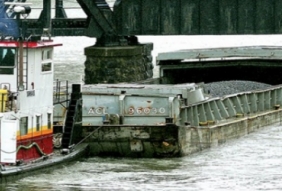
Posted on May 24, 2016
By Tracie Mauriello, Pittsburgh Post-Gazette
Legislation slowly winding its way through Congress would fund long-awaited improvements to the nation’s aging waterways infrastructure, including replacement of three locks on the upper Ohio River.
First, though, the Army Corps of Engineers has to finalize its Upper Ohio Navigation Study, which is 13 years and $17 million in the making. That should be done by fall, Maj. Gen. Donald Ed Jackson of the Corps of Engineers told an impatient House panel this week.
If it isn’t, plans to replace deteriorating locks and dams could be delayed until 2018, when Congress is scheduled to consider its next water resources development bill.
The U.S. Senate last week took an important step toward funding the work when it passed a $37.5 billion appropriations bill for energy and water programs, including nearly $3.2 billion for Corps of Engineers civil works projects. That’s $467 million more than President Barack Obama requested in his budget.
The House is working on its own plan, so the legislation is likely headed to a conference committee.
That’s just the first hurdle.
Congress also must pass a separate authorization bill allowing specific projects to be funded, and that can’t happen until the Corps of Engineers presents its feasibility study to Congress.
The study recommends replacing the Emsworth, Dashields and Montgomery locks on the Upper Ohio at a combined cost of $2.3 billion.
At least half the cost of major river projects is funded through a 29-cent per gallon tax on diesel fuel that barge operators pay. The rest comes from federal taxpayers.
The work is crucial to the economy, which depends on a system of waterways to transport goods through the middle of the country.
“Unscheduled repairs are devastating,” said Mary Ann Bucci, interim executive director of the Port of Pittsburgh Commission.
“It isn’t like a road closure when you might be able tot ake another road. You can’t do that. You’ve got to sit and wait for the lock to reopen, and if a plant is depending on raw materials that can’t get there, it’s devastating,” she said.
Barge operators say they often have to wait hours – and sometimes days – for their turn to pass through the upper Ohio River’s narrow channels while locks are under seemingly perpetual repair. The older locks and dams are, the more often they have to be closed for emergency repairs. Complete failure of lock and dam could be catastrophic for the regional economy, which is dependent on the abilty to use the Ohio River to transport coal, steel, grain, fuel and much more, operators said.
“Delays create a logistical nightmare,” said Michael J. Monahan, president of Campbell Transportation Co. in Houston, Pa., which operates 600 barges.
A 10-day trip down the Ohio can turn into two weeks, holding up deliveries of goods customers are counting on to produce everything from food to electricity to steel, Mr. Monahan said.
“Our boats are sitting there idle without moving. We’re paying for the crews and we’re paying for the equipment that’s not moving, and that’s where our losses get real big in a hurry,” he said.
Emworth, Dashiels and Montgomery aren’t the only locks in danger of failing. Many others throughout 12,000 miles of U.S. rivers are in similar disrepair including those on the lower Monongahela River at Braddock, Charleroi and Elizabeth.
The Senate bill includes $52 million for work on those locks.
Source: Pittsburgh Post-Gazette





